Pit Vipers
Pit vipers, also called pit Adders, belonging to the subfamily Crotalinae, are highly venomous snakes, native to the Americas and Asia. You do not find this pit viper snake in Africa and Europe, where the Viperidae or true vipers are found.
The distinguishing feature of the pit vipers is the presence of Thermosensitive or heat-sensing pits located on either side of the head, between the eye and the nostril. There are at present 18 recognized genera and 151 species of pit vipers in the old world as against 11 genera and 97 species in the new world. They represent the only Viperids found in America. The snakes in the group include Lance-heads, rattlesnakes, and Asian pit vipers. Crotalus is the subfamily of this genus type. One type of rattlesnake, under this group, is C. Horridus or the Timber Rattlesnake also called the banded rattlesnake or the canebrake rattlesnake.
All species of pit vipers have folding fangs that efficiently deliver potent venom to immobilize prey as well as to deter predators.
Anatomy
The pit vipers vary widely in size. They range in size from the small hump- nosed viper that grows to a maximum length of 45 centimeters or 18 inches, to the Bush master, which can grow to the length of 3.65 meters or 12 feet in length, certainly the longest venomous snakes of north America.
Extra Sensory Organs To Detect Prey
The group is unique in that all of them have a common characteristic, the fossa (a deep depression in the loreal region on either side of the head, between the eye and the nostril). These loreal pits are, in fact, external openings of a pair of highly sensitive organs that can detect infrared. This, in effect, provides the snakes a sixth sense to locate and as well as judge the size of the warm blooded prey they feed on.
Habitat

You find these snakes in the old world, starting from eastern Europe, further eastward all through Asia to Japan, Indonesia, Taiwan, Nepal, Indian peninsula and Sri Lanka. They also range from South Canada southward to central America to South America, in the Americas.
These are a highly adaptable group of snakes that you can find in diverse habitats ranging from the driest deserts (Example- Crotalus Cerases or sidewinder) to real rainforests (For example, Lachesis Muta or the Bushmaster), There are arboreal species and terrestrial ones. One species, the Cottonmouth, are even semi aquatic. The record for high altitude living is shared by Mexico’s Crotalus Triseriatus (Mojave rattlesnakes) and China’s Gloydius Strouchi (the Tibetan Pit Viper). Both the species can be found at elevations over 4000 meters above the sea level.
Predation
Being ambush predators, Croatalines patiently wait for their prey to wander near. The Chinese arboreal species Gloydius Shedaoensis, selects an ambush site and returns there every year during the spring migration of the birds. These snakes, even learn to improve the accuracy of their strike over a period of time. Most ambush pit vipers prey on frogs, lizards and rodents.
Reproduction
Most pit viper species are Ovoviviparous, meaning that they are live bearers, giving birth to baby snakes. The egg laying (oviparous) pit viper species include, Calloselasma (Malayan pit viper) Lachesis (Bushmasters) and some species of Trimeresurus (bamboo viper). All the viper species of America are ovoviviparous and baby vipers possess fangs and venom. Egg laying crotalines are supposed to take care of the eggs. Brood size can be as small as two for smaller species or as high as 86 for Bothrops Atrox, the most prolific live bearing snake.
Pit Vipers are divided mainly into the Asian and American types.
Asian Pit Vipers:
Asian Pit Viper (Trimeresurus Gramineus)

Asian (Pit) Vipers Belong to the species Trimeresurus gramineus. These pit vipers are venomous. These snakes are commonly found in Asia, ranging through India, Pakistan, China, all through Southeast Asia and the islands of the pacific. These snakes are also commonly called Asian (Lance-headed) Vipers or Asian Lance-heads. Most of the species are small and arboreal in nature. They have slender bodies and they have prehensile tails. Most of the pit vipers are green in color, but some species have markings of yellow, orange, red or black or even gold.
They feed primarily on amphibians, lizards, rodents and birds. Many viper species of the genus Trimeresurus are ovoviviparous or live bearers of young snakes.
There is variation in the toxicity of the venom between species, but the venom is hemotoxic in nature and of great medical significance to humans. Some locals call these snakes ‘100’ pace snakes based on the wrong idea of the potency of the venom. They believe the bite victim will drop dead before he can take a hundred steps.
The Vietnamese Pit Vipers

Trimeresurus cornutus commonly called Vietnamese pit vipers, are a venomous species of pit vipers, endemic to Vietnam. They are generally found in Tonkin and Bach Ma. The common name is Fan-Si-Pan (horned) pit viper. These are highly aggressive species and they possess large fangs. These vipers can strike at a distance of a half of its body length.
Japanese Pit Vipers

You can find Trimeresurus Elegans, or the Japanese pit viper in Ryukyu Islands, Japan.
Trimeresurus Eelegans are called by different names like, Elegant (pit) viper, Elegant (tree) viper and Sakihma Habu, in the local language. These are a species of venomous pit vipers.
Trimeresurus Jerdonii (Protobothrops Jerdonii)

Trimeresurus Jerdonii otherwise known as Jordon’s (pit) viper, are a species of venomous pit vipers native to Assam (India), Tibet, Myanmar and China. There are three subspecies of these snakes. The females are bigger than the males, with an overall length of 39 inches including the tail length of 6.3 inches. The males grow up to 32.9 inches with the tail accounting for 5.5 inches.
Asian Moccasins

Gloydius is the name of a genus of Asian venomous pit vipers that they also call as Asian Moccasins. Nine species have been recognized in the genus. There is a lot of resemblance between Gloydius genus and the Agkistrodon genus of America. In fact, due to strong similarity in morphology, these snakes were classified in the Agkistrodon genus till recently. We can find the snakes of this genus in Russia, ranging from the Ural mountains (East) through to Siberia, Iran, The Himalayan ranges, Nepal, India, Pakistan, Korea, China and Japan.
Temple Vipers (Southern India and Southeast Asia)
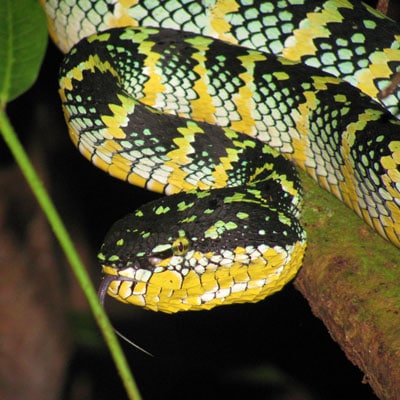
Tropidolaemus wagleri are called different names like Temple Viper, Wagler’s (pit) viper and temple (pit) viper. These are venomous pit vipers inhabiting southeast Asia. There are no currently recognized subspecies. These snakes are abundant around Malaysia’s Azure Cloud Temple, for which reason, these snakes are called temple vipers.
These Pit vipers exhibit sexual dimorphism. The females are larger than the males. While the females grow to a length of one meter, approximately, males do not grow to more than 75 centimeters in length. They possess large triangular heads. The body is relatively thin. The snakes are mostly arboreal (living high up in the trees). Their prehensile tails aid in climbing. We can find these snakes in a variety of patterns and colors of brown, black or green with red or yellow bands. These snakes prey on birds, lizards and rodents.
They are ovoviviparous. This means that they give birth to live young ones, 4 to 15 at a time.
Analysis of the venom shows that it contains 4 kinds of novel peptides identified as 1-4 wagerines that induce respiratory (fatal) paralysis in mice.
Mountain Pit Vipers (Ovophis Monticola)

Ovophis Monticola are also called mountain Vipers, Chinese (pit) vipers, spotted (pit) viper, Chinese mountain (pit) vipers and Arisan Habu. The females are much larger than the males. While the females can reach a length of 110 centimeters, males grow to less than half of the length of the females. The tail length of the females is 15 cms as against 8 centimeters of the males. On the head, there is a snout, a little larger than twice the eye’s diameter. Small scales, not large shields, cover the crown. The scales are imbricate (lapping each other) and smooth. In Asia, you find them in India, Nepal, Tibet, China, Taiwan, Hong Kong, Thailand, Cambodia, Vietnam, Laos, Singapore, Malaysia and Indonesia.
Mangshan Pit Viper (Trimeresurus Mangshanensis)

This exciting pit viper is taking the American exotic pet trade by storm and reptile enthusiasts are raving about this new entrant with its moss like pattern. They are camouflage experts. This pit viper species are endemic to China’s Guangdong and Hunan provinces and is characteristically known to spit venom.
Popes Pit Viper (Trimeresurus Popeorum)

This Pope’s Pit Viper is a beautiful, venomous and arboreal Pit Viper found in Indonesia, northern India and in Southeast Asia. They have three subspecies. They display sexual dimorphism (visually identifiable males and females) The males are vibrant green in color with two lateral lines in red, divided by two distinct conspicuous red and white lateral lines. This snake also has interesting and rare ruby eyes. They prefer living at elevations of about 800 meters.
Kanburi Pit Viper (Trimeresurus Kanburiensis)
These are a species of extremely venomous pit vipers, endemic to Thailand. They have a heavy build, but are arboreal, and have a tan color. The adults of the species attain about 30 inches length. They hunt at night and stay in the foliage to escape the daytime heat. They are nocturnal, but sometimes bask in the sun.
Hump-Nosed Viper
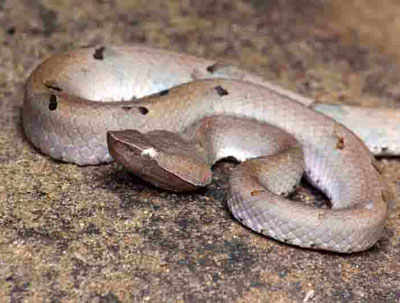
The hump nosed viper, or Hypnale Hypnale, also known as the Merrem’s Hump Nosed Viper, is a highly venomous species of pit viper that inhabits exclusively, Sri Lanka and India. They grow to an average length of 30-45 inches, with an upward turned snout with a hump, stout build and a wide head. They are mainly gray, with a heavy brown molting that is lined with two rows of dark spots. Their belly is yellowish and they have a tail with a red or yellow tip. They are highly venomous, their bites leading to renal failure. They bear live young ones.
Shedao Island Pit Viper
These Chinese Pit Vipers, Gloydius Sshedaoensis, commonly also called Shedao pit-vipers, are endemic only to the small Chinese Shedao Island, which is infested with extraordinarily large population of these snakes. They grow to about 65-70 centimeters, prey on songbirds or perching birds (known as passerine birds), and play the perfect role of an ambush predator, waiting on tree branches or on the ground.
Tibetan Pit Viper (Himalayophis Tibetanus)
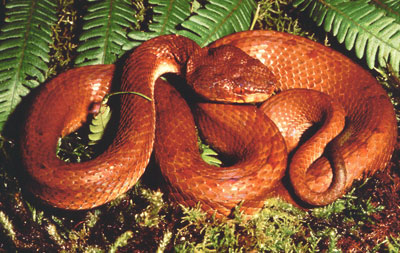
You can see this small venomous species of pit viper only in Western China (Tibet region) and Nepal. They grow only to a maximum length of 540 centimeters. They are stoutly built, have a reasonable sized head, and a moderate length of tail.
Malayan Pit Viper

The Malayan Pit Viper (Calloselasma), also called the Malayan Pitviper, is a monotypic genus belonging to the species of venomous pit vipers. You can find these snakes in Southeast Asia, extending from Thailand to the Island of Java in Northern Malaysia. These pit vipers grow to about 30 inches or 76 centimeters. Their favorite habitats are bamboo thickets, orchards, farmlands and forests adjacent to plantations.
Pit Vipers of the Americas and Mexico
We can find these snakes over most of the United States, extending south as far as Argentina in South America. Rattlesnakes are prevalent in South west America. Arizona has the maximum number of native species, which may be due to its varied ecology.
The species commonly seen in this region are the Western Diamond Back Rattlesnakes, Sidewinders, Mojave and Black-Tailed Rattlers.
Pit Viper species endemic to Mexico and the Americas are:
Speckled Rattlesnake Crotalus mitchelli Pyrrhus
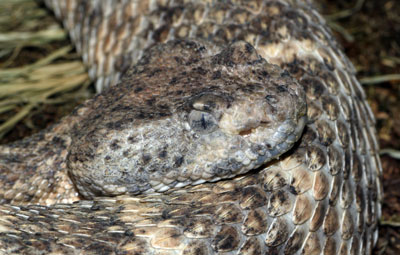
The Speckled Rattlesnake or Crotalus Mitchellii Pyrrhus, belongs to the highly venomous subspecies of pit vipers that inhabit Northwestern Mexico and the Southwest of the US. This snake has a medium size and prefers to live in rocky environments. They eat small mammals, and their color varies with the environment they live in.
Pit Viper Lachechis Muta from Ecuador (Bushmaster)

South (American) Bushmasters belong to the venomous Pit (viper) species Lachesis Muta. These snakes are natives of South America., including Trinidad Island. There are two currently recognized subspecies.
Adults reach an average length of 2-2.5 meters. Bush masters reaching 3 meters in length is by no means unusual. The largest specimen recorded was 3.65 meters long. This makes the Bushmaster, the largest of all vipers, and the Western Hemisphere’s longest venomous snake. The average weight of the species is around 3-5 kilos. “Bitis vipers” (normally endemic to Africa and the Arabian Peninsula), are comparatively heavier.
These snakes have broad heads distinct from the neck. The snouts are rounded broadly.
We can find these snakes in equatorial forests on the eastern side of the Andes, Northern Bolivia, Colombia, Peru, eastern Ecuador, Eastern and southern parts of Venezuela, Trinidad island, Surinam, Guyana, most of Brazil and French Guiana.
They inhabit primary as well as secondary forests, fields nearby, and clearings. They appear to prefer mountainous and hilly areas in Trinidad.
The impression is that, even though these vipers produce a large amount of venom, the potency may be less compared to other viper species. This need not be true. These reptiles stress easily and seldom live for a long time in captivity.
Ridgenose Pit Viper (Crotalus Willardi Obscurus)

Ridgenose pit vipers are rattlesnakes that are a venomous sub species of pit vipers. These snakes are native to the southwestern parts of United States and northwestern Mexico. This species has been listed as “threatened (venomous) snakes” by the United States Fish and Wildlife Service. These snakes are called by their common names, which include, Animas Ridgenose Rattlesnakes and Mexican Ridgenose rattlesnake. The Arizona Ridgenose rattlesnake is Arizona’s state reptile
These are basically small rattlesnakes and none of their subspecies measure longer than two feet. Usually, the color patterns are pale or white horizontal stripes on a base of dark brown. These patterns can vary slightly among subspecies. There are ridges on each side of the nose. These ridges are actually upturned scales. These ridges are unique to the species and the cause of their name.
These are a very reclusive species and we rarely see them outside their habitats at high elevations. They inhabit the wooded south west mountain ranges.
Rattlesnakes are basically ambush predators. They coil and lie in wait for the prey to come near striking distance. They feed on birds, small mammals, lizards and huge centipedes. The young snakes feed on these large centipedes and lizards. The adults concentrate on birds and mammals.
Due to the generally small size of the snake, venom discharge yields are low.
Diamondback Rattlesnakes (Crotalus Atrox)

Diamondback rattlesnakes (Western) They belong to Crotalus Atrox, a venomous species in the pit viper group. These snakes are found in Mexico and the united states. This species can be responsible for the major portion of the snake bite deaths in northern Mexico and the second largest number in USA after C. Adamanteus (eastern diamondback rattlesnake).These snakes are distributed from central US to Arkansas to central and southwestern California, southward to as far as northern Veracruz, Hidalgo and Sinaloa in Mexico.
The average length of the Adults is around 3.9 feet. You may, infrequently encounter specimens more than 4.9 feet long. And those over 5.9 are rare indeed. The maximum recorded length is 6.99 feet. Males grow larger than the females, but only after sexual maturity. The weight of a medium sized rattlesnake is around 2.7 Kg. Very large ones can weigh up to 6.7 Kg. The color can be dusty gray-brown, brick-red, pinkish-brown, chalky white or yellow. These species have a host of common names which include Western (Diamond-Backed) Rattle Snakes, Arizona (Diamond) Rattle Snake, Adobe Snake, Desert Diamond Back, Spitting Rattlesnake, Fierce Rattlesnake, Coon Tail, Texan and Texas (diamond) rattle snakes.
We can find them in habitats that vary from coastal flat plains to hillsides and rocky canyons. They are associated with different vegetation types that include mesquite grassland, deserts, creosote sand, desert scrub and forests of pine-oak.
The venom of this rattle snake, like most other pit vipers, has concentrated secretions called pretolytic enzymes that can destroy tissues. The venom is basically haemotoxic (prevents blood from clotting), affecting blood vessels, the heart and the blood cells. It also contains components that cause hemorrhage.
Mojave Rattlesnakes (Crotalus Scutulatus)
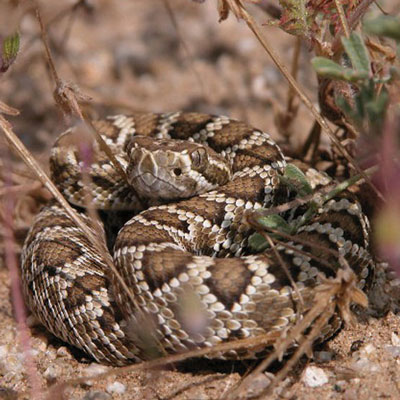
Mojave rattlesnakes belong to the species Crotalus scutulatus. . They are also called Mojave Green and Mojave rattle snakes. These are venomous pit viper species. You can find them in South western US deserts and central regions of Mexico. The venom of the snake is highly neurotoxic.
The average length of the snake is less than 100 cm. The maximum length is 137.3 cms.
Depending on the surroundings, the color can vary from many brown shades to pale green shade. The green hue has earned the snakes the name of Mojave greens.
These are primarily snakes of the desert or of the lower mountain slopes. you can find them near creosote or scrub brush and sparsely vegetated lowland areas, grassy plains, among Joshua tree woods and cacti.
This subspecies of Mohave rattlesnake are said to possess the most devastating and lethal venom among all snakes of North America. However, chances of survival are high if the bite victim gets immediate medical attention.
Black-tailed Rattlesnakes (Crotalus molossus)

Black-tailed rattlesnakes are of the species Crotalus Molluses. These are a venomous pit viper species found in Mexico and the southwestern US.
These are medium sized snakes that average 30 to 42 inches in length. Lengths up to 51 inches are reported, but rarely. The females are larger than the males.
The color varies from shades of yellow and olive green to brown and even black. The black tail is the distinguishing feature of the snake.
Black tails are carnivores like all rattlesnakes. They feed on small mammals, rodents, birds and small reptiles.
The breeding season is in spring. Males will follow the females’ pheromone trails. Copulation can last for hours and happen many times. Even after mating, the males stay near the females to scare off other suitors. The females are live bearers. After birth, the baby snakes stay with their mother for a day or two, then set off on their own. Females are said to breed every year and a litter can have 10 to 12 babies. The average size is four to six inches.
The average life span of the snake is between 10 and 20 years.
Copperheads (Agkistrodon Contortrix Laticinctus)

Apart from rattlesnakes, the only other member of the pit viper family of southwest America is the copperhead snake. Broad-banded copperheads belong to the species Agkistrodon contortrix laticinctus. You can find them only as far as Central Texas. Copperheads are small and rarely exceed 30 inches in length. Even though they are venomous and possess fangs, the venom quantity is low and less toxic compared to that of most rattlesnakes. Since they blend well with their habitats, they can ambush prey easily.
Jumping Pit Vipers From Mexico

Anthropodis are a genus of Venomous pit vipers, endemic to central America and Mexico. There are three currently recognized species. The common name might give the idea that they jump and attack prey and predators. You can take that with a pinch of salt. They are also called jumping vipers.
These are thick-bodied snakes. Of the three species, A. Nummifer is the stoutest and A. Picadoi , the most slender. They display a maximum length 47 inches. They have large heads, small eyes a broad round snout and a short tail.
The color pattern usually is gray or reddish brown with dorsal or lateral blotches, The ground color can vary between reddish brown, cream, yellow, black or purplish brown.
We can find these snakes in east Mexico’s mountains, southward to Versant (Atlantic) to the lowlands and central America.
The adult snakes prey on lizards and small mammals while juveniles subsist on skinks and orthopterans (a type of insect).
The venom is not potent. They cause only mild swelling and transient pain. The locals in Honduras insist that the snake is not venomous.
Eyelash Pit Vipers (Mexico) – Bothriechis Schlegelii

Eyelash (pit) Vipers belong to the species Bothriechis schlegelii. These are pit vipers found in south and central America. These are small arboreal snakes. They have a typically wide range of color variations. They also possess superciliary scales above the eyes, which look like eye lashes. They are the commonest green palm (pit) vipers.
These are a relatively small species of pit vipers. The adults are 22 to 32 inches long. The females are larger than the males. The heads are wide and triangular. The eyes have vertical pupils. They are solenoglyphous, meaning that their needle like fangs in the upper jaw can be folded back. They also have thermo sensitive pits on either both sides of the head located between the nostril and the eye.
Its most distinguishing features, and origin of its common name, is the set of modified scales over the eyes that look much like eyelashes. The eyelashes are thought to aid in camouflage.
Forest-Pit Vipers (Bothriopsis Bilineata)

Forest (pit) vipers are a genus of venomous (pit) vipers that are endemic to the South America’s Amazon basin. They are pale green in color and are arboreal. We can find them in eastern Panama and all through northern South America, including Colombia’s and Ecuador’s lowlands. You can also find them in the Andes Mountains, and Brazil’s Atlantic Forests. These snakes vary in size to approximately a maximum of 1 meter in length. These snakes are a great source of snake bites in the region. The prehensile tails and cryptic color patterning are all adaptations for arboreal life There is plenty of green in the color patterns. There may be dark or pale markings. You can also find two creamy lines running longitudinally along the body, bordering the ventrals.
Lanceheads (Bothrops Aspers)

Bothrthos Aspers are a species of venomous pit vipers. They range from southern Mexico to the Northern regions of South America. These snakes are called the ultimate pit vipers. We can find these snakes in varied lowland habitats, and frequently near human settlements. So they are considered more dangerous to humans. They account for the most snake bite incidents in their range.
We can identify these species by their broad, flat head, distinct from the rest of the body. The color of the head is dark brown or black.
These snakes may weigh up to 6 Kgs. They often reach 1.8 meters in length. The larger females can grow up to 2.5 meters.
Even though mostly a lowland species in Mexico, we can find them at altitudes up to 2500 meters and above in Venezuela and Colombia.
Together with Crotalus durissus, these snakes are the main cause of snake bites in the Yucatan of Mexico.
This snake is considered most dangerous as it accounts for 46% of all the snake bites in the region.
Ground Rattlesnakes (Sistrurus Miliarius)
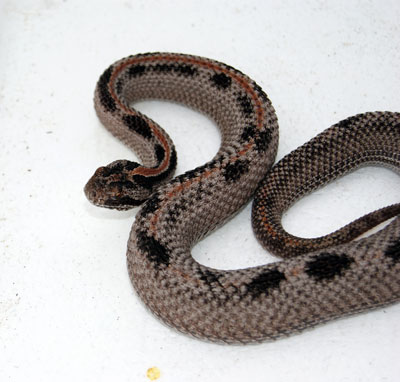
Ground Rattlers are known by many names that include pigmy, and eastern pigmy rattle snakes. They occur in South Eastern United States, from South and East Carolina to peninsular Florida and west to Texas and Oklahoma. They Inhabit Sandhills, Flatwoods, floodplains and in forests near marshes and lakes.
They are a small species that grow 16 to 24 inches in length. The maximum length reported is 31 inches.
The dorsal pattern is a number of oval or sub-circular spots with rather regular edges. The spots on the flanks are roundish. There are indistinct blotches found on adjacent scales.
The snakes feed on birds, lizards, small mammals, insects, frogs and even other snakes.
These snakes do not produce much venom. Though rarely fatal, it can give an unpleasant time for a few days.
Mexican Horned Pit Vipers (Ophryacus Undulatus)

This is a rare venomous snake species and very little is known about it. You can identify them easily by the raised scales above their eyes, which look like horns. They usually inhabit the central and Southern Mexican Mountain regions. The females deliver live young snakes.
These snakes vary in color throughout the range and grow up to 55 to 70 centimeters. They are active mostly only in the daytime, as the temperatures are low at night. They display various shades of gray and green in the upper parts with characteristic yellowish underparts. We can find an irregular, zigzag pattern on its back.
These snakes have triangular heads, long, curved, pointed fangs and vertical pupils. The hinged fangs lie flat against the roof of the mouth when the mouth is closed.
Malabar Pit Viper (Trimeresurus Malabaricus)

The Malabar Pit Viper or Trimeresurus Malabaricus is a venomous pit viper found in Southwestern India and grow a length of about 41 inches (105 centimeters). They are a nocturnal species inhabiting moist deciduous and evergreen forests. Their diet in the wild includes musk shrews, geckos, small animals and tree frogs.
Sumatran Pit Viper (Trimeresurus Sumatranus)

The Sumatran Pit Viper is a very venomous arboreal species belonging into Thailand, Indonesia and Malaysia. This snake has a green color with a red tail. The snake has a heavily built body and a prehensile tail. These adult vipers can grow up to nearly 63 inches (about 1.6 meters). Their fangs are about 10 CM long. They feed mainly on frogs, birds and mammals. They prefer to live in low forests at below 800 meters or 2500 feet above sea level.

Having discovered a fondness for insects while pursuing her degree in Biology, Randi Jones was quite bugged to know that people usually dismissed these little creatures as “creepy-crawlies”.







